#is EXACTLY the same as the marvel/disney visual shorthand for
Explore tagged Tumblr posts
Text
I love when they put him (/he puts himself) in this outfit, because he looks like nothing so much as a character in a Marvel movie trying to be 'incognito'.
Like.

This is Steve Rogers 'undercover' in Captain America: Civil War. You see what I mean.
beloved <3
#love that sid's idea of 'nice outfit for promotional material'#is EXACTLY the same as the marvel/disney visual shorthand for#'as bland as possible so it signals Definitely Normal Guy even though you're meant to know this Guy is Decidedly Not Normal#and is in fact Special and Central to the Narrative Even'#it's a perfect look for sid. but do you think he is self aware enough to realize what he's doing#is he becoming genre-aware? is he situating himself within the realm of metafiction in real actual life??#sidney crosby#captain america#video
345 notes
·
View notes
Text
On Frozen 2 and Disney’s nostalgia problem
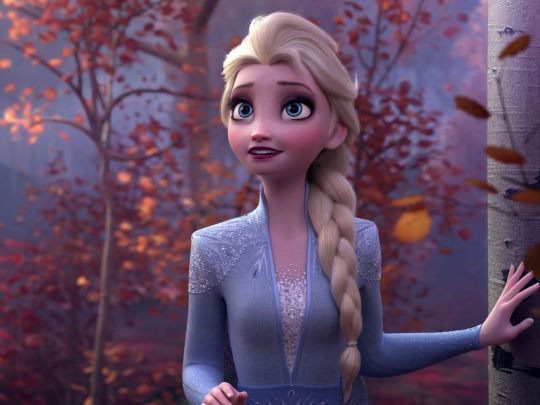
Elsa’s back. | Walt Disney Pictures
Disney used to always be looking forward. These days, it increasingly only looks back.
Nobody was more nostalgic than Marcel Proust.
The French novelist’s six-volume masterwork In Search of Lost Time is narrated by a man who’s remembering his youth, and it explores how strange and unreliable memory can be. Throughout the series, the notion of “involuntary” memory is a recurring theme, but it’s particularly important in the famous “madeleine” scene.
The scene comes early in the first volume, Swann’s Way, when the taste of a madeleine dipped in tea immediately plunges the narrator into a vivid childhood memory. It’s so well-known that it remains a cultural reference point even today, more than a century after Swann’s Way was published: To say that something is your “madeleine” is shorthand for any sensory experience that brings back a flood of childhood memories (even though mounting evidence suggests that Proust’s version may have just been soggy toast).
That sensory experiences can trigger powerful memories, particularly of youth and childhood, was not a particularly earth-shattering insight on Proust’s part — lots of people have had similar episodes. And while not all of his narrator’s recollections are fond, a lot of them seem presented through a haze of affection — the reliability of which, as the narrator us himself, is a little suspect. “Remembrance of things past is not necessarily the remembrance of things as they were,” he writes.
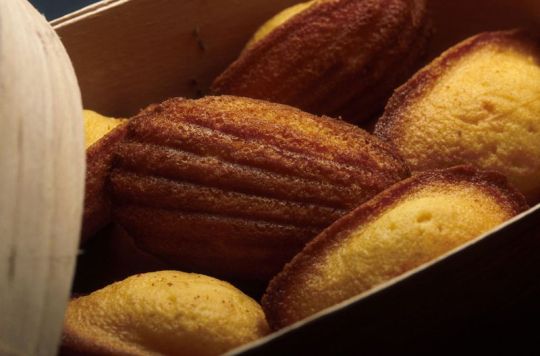
Maurice Rougemont/Gamma-Rapho/Getty Images
Marcel Proust famously wrote about madeleines as he explored the ways our memories are triggered.
Proust aptly describes the concept of nostalgia: a sentimental yearning for the past, which Merriam Webster defines, succinctly and evocatively, as “the state of being homesick.” And while we periodically recall certain moments as being worse than they actually were (I think of the 30 Rock episode in which Liz Lemon is shocked to discover that her memories of being bullied in high school are faulty, and she was the one doing the bullying), the past often takes on a rosy hue.
Time, distance, and the occasional dash of willful ignorance are effective modifiers. They’re why societies collectively hallucinate Golden Ages, and why so many people find the idea of making America “great again” appealing. It’s less about conserving the good of the past, and more about rejecting the present.
Nostalgia is not, as a mood, inherently bad. Sometimes, feeling a bit homesick is good. But when that feeling becomes our default posture, our guiding light, it starts to become ... troubling? Inhibiting, maybe? Stifling? If the past was when things were good, why bother to build a new future? Better to just keep reinventing the past.
Which brings us to Disney, and to Frozen 2.
Disney used to be a company that looked forward. These days, it seems more interested in looking back.
Disney now controls the lion’s share of the movie industry. In 2019 so far, five of the six highest-grossing films worldwide have been Disney properties; the sixth (Spider-Man: Far From Home) was a joint endeavor between Sony and Disney-owned Marvel. The company’s reach is staggering: It owns, among scores other entities, Pixar, the Marvel Cinematic Universe, Star Wars, and as of earlier this year, the film and TV assets formerly held by 21st Century Fox — in addition to its own extensive and much-beloved back catalog, lots of which is now available to stream via the just-launched Disney+ service.
Disney is in the entertainment business. But what it’s selling isn’t entertainment, exactly — that’s just the vehicle for its real product, and that product has shifted and morphed over time. At one time, a big part of what Disney was selling was a vision of a utopian future, as you know, if you’ve been to Tomorrowland or Epcot at Walt Disney World.
In his speech at the opening day of Disneyland in 1955, Walt Disney himself pointed to his vision of the park as a place where nostalgia and forward-looking inspiration could coexist: “Here age relives fond memories of the past, and here youth may savor the challenge and promise of the future.”
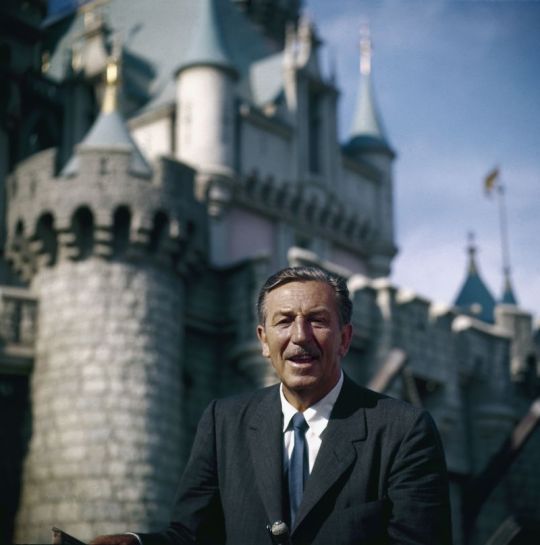
Allan Grant/The LIFE Picture Collection via Getty Images
Walt Disney at the Disneyland grand opening in 1955.
But as we come to the end of this banner year for Disney, it’s clear that what the company wants to sell us, going forward, is a seemingly infinite heap of Proustian madeleines. Certainly the warm fuzzies have been one of Disney’s main exports for a long time, but some kind of tipping point was reached in 2019. Now, it seems evident that Disney sees provoking existential homesickness as its main job. Nostalgia is its real product.
Consider Toy Story 4, the fourth film in a series that debuted in November 1995. If you were 8 years old and saw Toy Story in theaters when it opened, you might have brought your own 8-year-old to see the new film earlier this year.
That’s a remarkable stretch of time, and the Toy Story series has stayed remarkably thematically coherent over that time. It’s a set of stories about the passage of time, about how nothing stays the same, about the fact that kids grow up and leave home — that’s why Toy Story 3 left parents bawling when Andy finally grew up and didn’t need his toys anymore. The toys, in a sense, are the parents’ stand-ins. And Toy Story 4, in which some of the toys opt to live a child-free life, feels an awful lot like a movie about being an empty nester, something that could render a parent munching popcorn with their third grader a bit verklempt, thinking about their own now-empty-nester parents who once took them to see Toy Story.
That’s the good kind of nostalgia. And the Toy Story series has successfully refreshed its basic premise over two decades — toys get lost, toys get found — in part through its willingness to surprise viewers, to crack jokes and be a little creepy and think outside the (toy) box with its narratives. So when we find ourselves feeling homesick, in a story about the passage of time, it works.
I think of this approach as generative nostalgia. It’s a way for Disney to use memory, to tap into the audience’s particular madeleines, to bolster the storytelling itself (and make an enormous wad of cash, too). Not every attempt lands, but when movie studios try to tap into nostalgia in order to generate fresh new stories with universal themes, to get creative with the familiar, it’s a good thing for art.
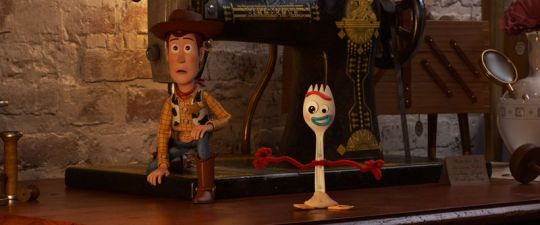
Pixar Animation Studios / Walt Disney Pictures
From Toy Story 4, we got Forky.
If Toy Story 4 was an example of Disney harnessing generative nostalgia, however, its so-called “live-action” remake of The Lion King was just the opposite. The film was never meant to be a standalone movie; its success was always fully dependent on the long-entrenched popularity of the 1994 animated film it recreates, in some cases shot for shot. It’s an entirely unnecessary movie — a way for Disney to test-drive high-end, lifelike CGI and get people to pay for it. And without the imaginative, sometimes visually wild artwork of the original, it falls very flat, with no new perspective on its source material.
Call it derivative nostalgia: For most audiences, The Lion King and Disney’s other live-action remakes (Aladdin was another huge hit this year) are interesting only insofar as they promise to deliver a (slightly) new spin on a beloved classic, without straying too far. We still get “Can You Feel the Love Tonight,” but it’s Donald Glover and Beyoncé. A copy of the original with some of the details tweaked. That’s the appeal.
And while derivative nostalgia has its place — we rewatch our favorite movies for a reason, because we like the feelings and memories they provoke — Disney seems intent on adopting it as a modus operandi, judging from the number of remakes the company has announced. It will depend on the built-in audience of people who loved Lady and the Tramp or 101 Dalmatians to pony up for a ticket or subscribe to Disney+ and ensure these projects’ success.
But I’m convinced the urge to use your giant piles of money to endlessly replicate the past can’t be good for a culture. Certainly, human culture is cumulative; we’re always building on what came before. For millennia, storytellers have leaned on the same material, like myths and archetypes, to find new ways to tell stories. But derivative nostalgia stymies the creative impulse, miring us in the same thing over and over again and training audiences to demand the predictable. Vanilla pudding tastes good, but there’s a lot more to food than vanilla pudding.
You can witness the battle for Disney’s soul happening inside Frozen 2
These generative and derivative modes of nostalgia seem to be warring inside inside Frozen 2, which is pleasing and enjoyable even if it’s clearly designed to function as an ATM for Disney, with Frozen’s previously established fanbase acting as the bank account behind the screen. It is, thank God, no Olaf’s Frozen Adventure.
The Frozen films are aimed primarily at little girls and boys, of course — Disney’s long-running core constituency for stories about princesses and talking animals (or snowmen). But, given that the first movie came out six years ago, Frozen 2 is also for older kids. And one of the most notable things about the movie is that it’s also for their parents.
Perhaps following Pixar’s lead, the more traditional Disney Animation studio has caught onto the fact that if you want grown-ups to be happy when they take kids to the movie theater, you’ve got to make something they’ll enjoy, too. So Frozen 2 leans (more noticeably than its predecessor) into jokes the adults will appreciate, and one in particular: While the kids at my screening howled at Olaf’s slapsticky misadventures, the adults were the ones laughing as Princess Anna’s hunky boyfriend Kristoff crooned his very ’80s-sounding power ballad “Lost in the Woods.”
During a recent interview, Josh Gad (who voices Olaf) joked that the song “speaks to all of us that grew up in the ’80s.” And he’s totally right. The voice of Kristoff, Jonathan Groff, says he was surprised when the song was handed to him: “I couldn’t believe that they were going to go there,” he said, calling it “truly shocking” and later saying it has the energy of Michael Bolton. The song is about how much Kristoff needs Anna in his life; in the film, he sings it during a fantasy sequence of finding her, backed by a chorus of singing reindeer. (The official Frozen 2 soundtrack includes a version of the song by Weezer, which kind of says everything.)
As Gad pointed out, it’s definitely a sight gag for the olds in the room — the younger Gen X and older millennial parents who’ve come to see Frozen 2 with their kids, and are now being rewarded with their own extended musical joke. What’s funny about it is that the musical-style “Into the Woods” parodies was already ridiculous by the time most gen-Xers and millennials became adults; what we’re reminded of now is the sheer goofiness that was so prevalent back then, when romantic ballads were sung by guys with bad hair surrounded by unironic kitsch.
Kids born in the 21st century won’t get the joke. But Frozen 2 isn’t exclusively for them; it’s for 20th-century kids, too. In fact, though its action is set just three years after the end of Frozen, it is, like Toy Story, about the passage of time, and what it’s like to grow older. Olaf sings a song about how things don’t make sense to him now, but they will someday; Anna and Olaf reflect on how they hope everything will stay the same, even though — spoiler alert — of course, they won’t.
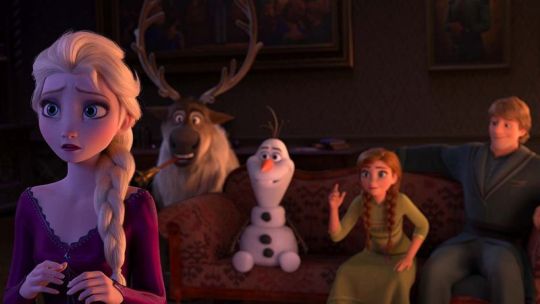
Walt Disney Pictures
The gang’s all back together in Frozen 2.
So Frozen 2 provokes all kinds of nostalgia. For kids who’ve already spent years dressing up as Anna and Elsa and driving their parents to distraction with “Let It Go,” the new film is a return to the happy land of Arendelle, where they’ve had many adventures. For teenagers who saw the original Frozen when they were 8 or so, but are now in high school, it’s a reminder of how far they’ve come. And for adults, it tugs on decades-old heartstrings — not just the chuckling memory of’ 80s power ballads, which might be the madeleine that reminds some of dancing at prom, but also the Disney princess stories so many of us grew up watching.
Whereas the original Frozen is a bit of an odd film — its plot structure feels a little out-of-sync with Disney’s usual storytelling, and its “true love’s kiss” comes not from a prince but a sister — Frozen 2 is much more conventional. Frozen retained some of the eerie strangeness of the Hans Christian Andersen fairy tale it was (very) loosely based on; Frozen 2 goes back to the usual adventure-and-return structure that has made so many classic Disney movies a success. It’s familiar. It’s comfortable.
By my lights, Frozen 2 is still a plenty enjoyable film, even if it lacks its predecessor’s subversive spark. But for me, watching generative and derivative nostalgia spar within it prompted a different sense of the familiar: bleakness about the future of mouse-eared entertainment. Disney, whatever its faults, has often been a pioneer in storytelling; now it’s resting firmly on its laurels, too often electing to spin the wheel again rather than try to reinvent it.
Nostalgia has its place. Remembering the feeling of homesickness reminds us where we came from, that we come from somewhere. But too much yearning for the past without a concomitant attempt to live in the present and push toward the future is a dangerous trap for a culture to fall into, both because it risks becoming stagnant in its art and because it may begin to to worship the past as the only place worth living in. Too much yearning for the past makes us incurious about the world. And if, as Proust wrote, the past we remember is not necessarily the one that existed, remaining stubbornly beholden to it can render us altogether incapable of dealing with the present.
The bigger Disney gets, the more it controls what most Americans — and people around the world — will see at the movies and on their TV screens, and thus it bears enormous responsibility for seeing into the future. Looking backward too much, recycling old content and relying on old formulas endlessly, becomes a snake eating its own tail.
As the endless stream of reboots and remakes and sequels and revivals that currently dominates entertainment attests, nostalgia sells. But it is also the thing most easily packaged to sell. Recycling content is the low-hanging fruit. And when Disney leans into the least creative sort of recycled content, live-action remakes — something nobody’s really asking for — it’s signaling how little it’s interested in originality.
Even when those remakes take a risk — for instance, by casting black actress Halle Bailey as Ariel in The Little Mermaid — it’s worth noting how safe the “risk” really is. Being a creative leader who celebrates inclusivity means daring to build something new, and trusting the artists to draw audiences into a new story. It doesn’t mean casting new faces in old, well-trodden roles with guaranteed built-in audiences because you’re not sure audiences will turn up otherwise. It doesn’t mean defaulting to reviving your past.
Which, ironically, is something Walt Disney was determined to keep his company from doing. As quoted in the 2007 Disney animated film Meet the Robinsons, he pushed for just the opposite: “Around here, however, we don’t look backwards for very long. We keep moving forward, opening up new doors and doing new things, because we’re curious. And curiosity keeps leading us down new paths.”
Frozen 2 opens in theaters on November 21.
from Vox - All https://ift.tt/2OvMLXf
1 note
·
View note
Text
On Frozen 2 and Disney’s nostalgia problem
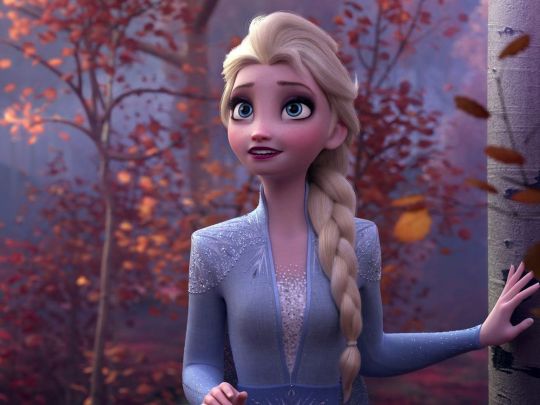
Elsa’s back. | Walt Disney Pictures
Disney used to always be looking forward. These days, it increasingly only looks back.
Nobody was more nostalgic than Marcel Proust.
The French novelist’s six-volume masterwork In Search of Lost Time is narrated by a man who’s remembering his youth, and it explores how strange and unreliable memory can be. Throughout the series, the notion of “involuntary” memory is a recurring theme, but it’s particularly important in the famous “madeleine” scene.
The scene comes early in the first volume, Swann’s Way, when the taste of a madeleine dipped in tea immediately plunges the narrator into a vivid childhood memory. It’s so well-known that it remains a cultural reference point even today, more than a century after Swann’s Way was published: To say that something is your “madeleine” is shorthand for any sensory experience that brings back a flood of childhood memories (even though mounting evidence suggests that Proust’s version may have just been soggy toast).
That sensory experiences can trigger powerful memories, particularly of youth and childhood, was not a particularly earth-shattering insight on Proust’s part — lots of people have had similar episodes. And while not all of his narrator’s recollections are fond, a lot of them seem presented through a haze of affection — the reliability of which, as the narrator us himself, is a little suspect. “Remembrance of things past is not necessarily the remembrance of things as they were,” he writes.
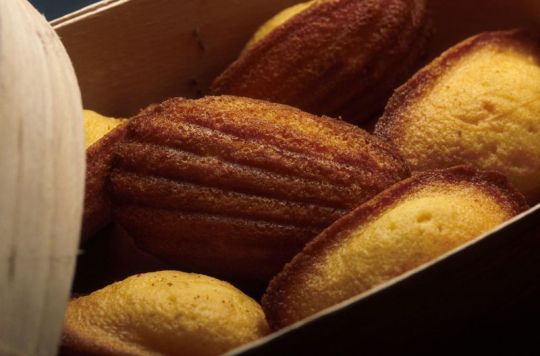
Maurice Rougemont/Gamma-Rapho/Getty Images
Marcel Proust famously wrote about madeleines as he explored the ways our memories are triggered.
Proust aptly describes the concept of nostalgia: a sentimental yearning for the past, which Merriam Webster defines, succinctly and evocatively, as “the state of being homesick.” And while we periodically recall certain moments as being worse than they actually were (I think of the 30 Rock episode in which Liz Lemon is shocked to discover that her memories of being bullied in high school are faulty, and she was the one doing the bullying), the past often takes on a rosy hue.
Time, distance, and the occasional dash of willful ignorance are effective modifiers. They’re why societies collectively hallucinate Golden Ages, and why so many people find the idea of making America “great again” appealing. It’s less about conserving the good of the past, and more about rejecting the present.
Nostalgia is not, as a mood, inherently bad. Sometimes, feeling a bit homesick is good. But when that feeling becomes our default posture, our guiding light, it starts to become ... troubling? Inhibiting, maybe? Stifling? If the past was when things were good, why bother to build a new future? Better to just keep reinventing the past.
Which brings us to Disney, and to Frozen 2.
Disney used to be a company that looked forward. These days, it seems more interested in looking back.
Disney now controls the lion’s share of the movie industry. In 2019 so far, five of the six highest-grossing films worldwide have been Disney properties; the sixth (Spider-Man: Far From Home) was a joint endeavor between Sony and Disney-owned Marvel. The company’s reach is staggering: It owns, among scores other entities, Pixar, the Marvel Cinematic Universe, Star Wars, and as of earlier this year, the film and TV assets formerly held by 21st Century Fox — in addition to its own extensive and much-beloved back catalog, lots of which is now available to stream via the just-launched Disney+ service.
Disney is in the entertainment business. But what it’s selling isn’t entertainment, exactly — that’s just the vehicle for its real product, and that product has shifted and morphed over time. At one time, a big part of what Disney was selling was a vision of a utopian future, as you know, if you’ve been to Tomorrowland or Epcot at Walt Disney World.
In his speech at the opening day of Disneyland in 1955, Walt Disney himself pointed to his vision of the park as a place where nostalgia and forward-looking inspiration could coexist: “Here age relives fond memories of the past, and here youth may savor the challenge and promise of the future.”
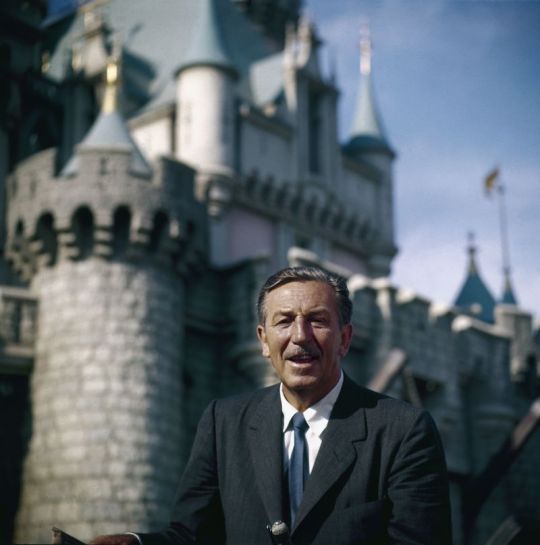
Allan Grant/The LIFE Picture Collection via Getty Images
Walt Disney at the Disneyland grand opening in 1955.
But as we come to the end of this banner year for Disney, it’s clear that what the company wants to sell us, going forward, is a seemingly infinite heap of Proustian madeleines. Certainly the warm fuzzies have been one of Disney’s main exports for a long time, but some kind of tipping point was reached in 2019. Now, it seems evident that Disney sees provoking existential homesickness as its main job. Nostalgia is its real product.
Consider Toy Story 4, the fourth film in a series that debuted in November 1995. If you were 8 years old and saw Toy Story in theaters when it opened, you might have brought your own 8-year-old to see the new film earlier this year.
That’s a remarkable stretch of time, and the Toy Story series has stayed remarkably thematically coherent over that time. It’s a set of stories about the passage of time, about how nothing stays the same, about the fact that kids grow up and leave home — that’s why Toy Story 3 left parents bawling when Andy finally grew up and didn’t need his toys anymore. The toys, in a sense, are the parents’ stand-ins. And Toy Story 4, in which some of the toys opt to live a child-free life, feels an awful lot like a movie about being an empty nester, something that could render a parent munching popcorn with their third grader a bit verklempt, thinking about their own now-empty-nester parents who once took them to see Toy Story.
That’s the good kind of nostalgia. And the Toy Story series has successfully refreshed its basic premise over two decades — toys get lost, toys get found — in part through its willingness to surprise viewers, to crack jokes and be a little creepy and think outside the (toy) box with its narratives. So when we find ourselves feeling homesick, in a story about the passage of time, it works.
I think of this approach as generative nostalgia. It’s a way for Disney to use memory, to tap into the audience’s particular madeleines, to bolster the storytelling itself (and make an enormous wad of cash, too). Not every attempt lands, but when movie studios try to tap into nostalgia in order to generate fresh new stories with universal themes, to get creative with the familiar, it’s a good thing for art.

Pixar Animation Studios / Walt Disney Pictures
From Toy Story 4, we got Forky.
If Toy Story 4 was an example of Disney harnessing generative nostalgia, however, its so-called “live-action” remake of The Lion King was just the opposite. The film was never meant to be a standalone movie; its success was always fully dependent on the long-entrenched popularity of the 1994 animated film it recreates, in some cases shot for shot. It’s an entirely unnecessary movie — a way for Disney to test-drive high-end, lifelike CGI and get people to pay for it. And without the imaginative, sometimes visually wild artwork of the original, it falls very flat, with no new perspective on its source material.
Call it derivative nostalgia: For most audiences, The Lion King and Disney’s other live-action remakes (Aladdin was another huge hit this year) are interesting only insofar as they promise to deliver a (slightly) new spin on a beloved classic, without straying too far. We still get “Can You Feel the Love Tonight,” but it’s Donald Glover and Beyoncé. A copy of the original with some of the details tweaked. That’s the appeal.
And while derivative nostalgia has its place — we rewatch our favorite movies for a reason, because we like the feelings and memories they provoke — Disney seems intent on adopting it as a modus operandi, judging from the number of remakes the company has announced. It will depend on the built-in audience of people who loved Lady and the Tramp or 101 Dalmatians to pony up for a ticket or subscribe to Disney+ and ensure these projects’ success.
But I’m convinced the urge to use your giant piles of money to endlessly replicate the past can’t be good for a culture. Certainly, human culture is cumulative; we’re always building on what came before. For millennia, storytellers have leaned on the same material, like myths and archetypes, to find new ways to tell stories. But derivative nostalgia stymies the creative impulse, miring us in the same thing over and over again and training audiences to demand the predictable. Vanilla pudding tastes good, but there’s a lot more to food than vanilla pudding.
You can witness the battle for Disney’s soul happening inside Frozen 2
These generative and derivative modes of nostalgia seem to be warring inside inside Frozen 2, which is pleasing and enjoyable even if it’s clearly designed to function as an ATM for Disney, with Frozen’s previously established fanbase acting as the bank account behind the screen. It is, thank God, no Olaf’s Frozen Adventure.
The Frozen films are aimed primarily at little girls and boys, of course — Disney’s long-running core constituency for stories about princesses and talking animals (or snowmen). But, given that the first movie came out six years ago, Frozen 2 is also for older kids. And one of the most notable things about the movie is that it’s also for their parents.
Perhaps following Pixar’s lead, the more traditional Disney Animation studio has caught onto the fact that if you want grown-ups to be happy when they take kids to the movie theater, you’ve got to make something they’ll enjoy, too. So Frozen 2 leans (more noticeably than its predecessor) into jokes the adults will appreciate, and one in particular: While the kids at my screening howled at Olaf’s slapsticky misadventures, the adults were the ones laughing as Princess Anna’s hunky boyfriend Kristoff crooned his very ’80s-sounding power ballad “Lost in the Woods.”
During a recent interview, Josh Gad (who voices Olaf) joked that the song “speaks to all of us that grew up in the ’80s.” And he’s totally right. The voice of Kristoff, Jonathan Groff, says he was surprised when the song was handed to him: “I couldn’t believe that they were going to go there,” he said, calling it “truly shocking” and later saying it has the energy of Michael Bolton. The song is about how much Kristoff needs Anna in his life; in the film, he sings it during a fantasy sequence of finding her, backed by a chorus of singing reindeer. (The official Frozen 2 soundtrack includes a version of the song by Weezer, which kind of says everything.)
As Gad pointed out, it’s definitely a sight gag for the olds in the room — the younger Gen X and older millennial parents who’ve come to see Frozen 2 with their kids, and are now being rewarded with their own extended musical joke. What’s funny about it is that the musical-style “Into the Woods” parodies was already ridiculous by the time most gen-Xers and millennials became adults; what we’re reminded of now is the sheer goofiness that was so prevalent back then, when romantic ballads were sung by guys with bad hair surrounded by unironic kitsch.
Kids born in the 21st century won’t get the joke. But Frozen 2 isn’t exclusively for them; it’s for 20th-century kids, too. In fact, though its action is set just three years after the end of Frozen, it is, like Toy Story, about the passage of time, and what it’s like to grow older. Olaf sings a song about how things don’t make sense to him now, but they will someday; Anna and Olaf reflect on how they hope everything will stay the same, even though — spoiler alert — of course, they won’t.
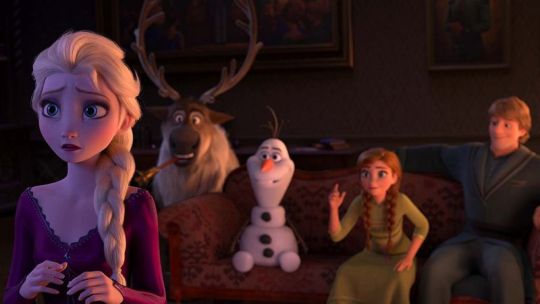
Walt Disney Pictures
The gang’s all back together in Frozen 2.
So Frozen 2 provokes all kinds of nostalgia. For kids who’ve already spent years dressing up as Anna and Elsa and driving their parents to distraction with “Let It Go,” the new film is a return to the happy land of Arendelle, where they’ve had many adventures. For teenagers who saw the original Frozen when they were 8 or so, but are now in high school, it’s a reminder of how far they’ve come. And for adults, it tugs on decades-old heartstrings — not just the chuckling memory of’ 80s power ballads, which might be the madeleine that reminds some of dancing at prom, but also the Disney princess stories so many of us grew up watching.
Whereas the original Frozen is a bit of an odd film — its plot structure feels a little out-of-sync with Disney’s usual storytelling, and its “true love’s kiss” comes not from a prince but a sister — Frozen 2 is much more conventional. Frozen retained some of the eerie strangeness of the Hans Christian Andersen fairy tale it was (very) loosely based on; Frozen 2 goes back to the usual adventure-and-return structure that has made so many classic Disney movies a success. It’s familiar. It’s comfortable.
By my lights, Frozen 2 is still a plenty enjoyable film, even if it lacks its predecessor’s subversive spark. But for me, watching generative and derivative nostalgia spar within it prompted a different sense of the familiar: bleakness about the future of mouse-eared entertainment. Disney, whatever its faults, has often been a pioneer in storytelling; now it’s resting firmly on its laurels, too often electing to spin the wheel again rather than try to reinvent it.
Nostalgia has its place. Remembering the feeling of homesickness reminds us where we came from, that we come from somewhere. But too much yearning for the past without a concomitant attempt to live in the present and push toward the future is a dangerous trap for a culture to fall into, both because it risks becoming stagnant in its art and because it may begin to to worship the past as the only place worth living in. Too much yearning for the past makes us incurious about the world. And if, as Proust wrote, the past we remember is not necessarily the one that existed, remaining stubbornly beholden to it can render us altogether incapable of dealing with the present.
The bigger Disney gets, the more it controls what most Americans — and people around the world — will see at the movies and on their TV screens, and thus it bears enormous responsibility for seeing into the future. Looking backward too much, recycling old content and relying on old formulas endlessly, becomes a snake eating its own tail.
As the endless stream of reboots and remakes and sequels and revivals that currently dominates entertainment attests, nostalgia sells. But it is also the thing most easily packaged to sell. Recycling content is the low-hanging fruit. And when Disney leans into the least creative sort of recycled content, live-action remakes — something nobody’s really asking for — it’s signaling how little it’s interested in originality.
Even when those remakes take a risk — for instance, by casting black actress Halle Bailey as Ariel in The Little Mermaid — it’s worth noting how safe the “risk” really is. Being a creative leader who celebrates inclusivity means daring to build something new, and trusting the artists to draw audiences into a new story. It doesn’t mean casting new faces in old, well-trodden roles with guaranteed built-in audiences because you’re not sure audiences will turn up otherwise. It doesn’t mean defaulting to reviving your past.
Which, ironically, is something Walt Disney was determined to keep his company from doing. As quoted in the 2007 Disney animated film Meet the Robinsons, he pushed for just the opposite: “Around here, however, we don’t look backwards for very long. We keep moving forward, opening up new doors and doing new things, because we’re curious. And curiosity keeps leading us down new paths.”
Frozen 2 opens in theaters on November 21.
from Vox - All https://ift.tt/2OvMLXf
0 notes
Text
On Frozen 2 and Disney’s nostalgia problem
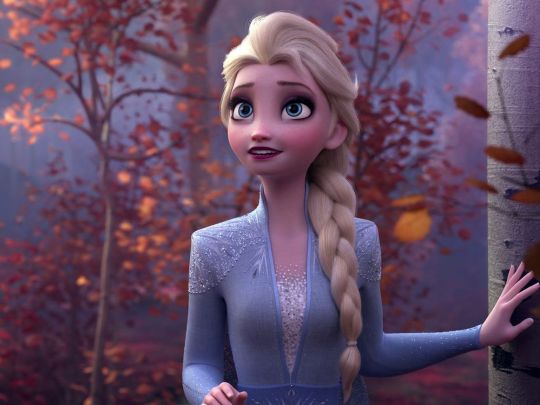
Elsa’s back. | Walt Disney Pictures
Disney used to always be looking forward. These days, it increasingly only looks back.
Nobody was more nostalgic than Marcel Proust.
The French novelist’s six-volume masterwork In Search of Lost Time is narrated by a man who’s remembering his youth, and it explores how strange and unreliable memory can be. Throughout the series, the notion of “involuntary” memory is a recurring theme, but it’s particularly important in the famous “madeleine” scene.
The scene comes early in the first volume, Swann’s Way, when the taste of a madeleine dipped in tea immediately plunges the narrator into a vivid childhood memory. It’s so well-known that it remains a cultural reference point even today, more than a century after Swann’s Way was published: To say that something is your “madeleine” is shorthand for any sensory experience that brings back a flood of childhood memories (even though mounting evidence suggests that Proust’s version may have just been soggy toast).
That sensory experiences can trigger powerful memories, particularly of youth and childhood, was not a particularly earth-shattering insight on Proust’s part — lots of people have had similar episodes. And while not all of his narrator’s recollections are fond, a lot of them seem presented through a haze of affection — the reliability of which, as the narrator us himself, is a little suspect. “Remembrance of things past is not necessarily the remembrance of things as they were,” he writes.
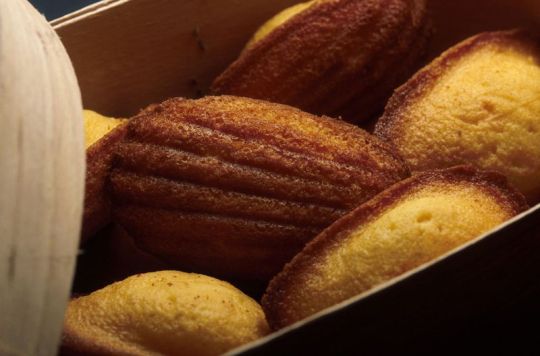
Maurice Rougemont/Gamma-Rapho/Getty Images
Marcel Proust famously wrote about madeleines as he explored the ways our memories are triggered.
Proust aptly describes the concept of nostalgia: a sentimental yearning for the past, which Merriam Webster defines, succinctly and evocatively, as “the state of being homesick.” And while we periodically recall certain moments as being worse than they actually were (I think of the 30 Rock episode in which Liz Lemon is shocked to discover that her memories of being bullied in high school are faulty, and she was the one doing the bullying), the past often takes on a rosy hue.
Time, distance, and the occasional dash of willful ignorance are effective modifiers. They’re why societies collectively hallucinate Golden Ages, and why so many people find the idea of making America “great again” appealing. It’s less about conserving the good of the past, and more about rejecting the present.
Nostalgia is not, as a mood, inherently bad. Sometimes, feeling a bit homesick is good. But when that feeling becomes our default posture, our guiding light, it starts to become ... troubling? Inhibiting, maybe? Stifling? If the past was when things were good, why bother to build a new future? Better to just keep reinventing the past.
Which brings us to Disney, and to Frozen 2.
Disney used to be a company that looked forward. These days, it seems more interested in looking back.
Disney now controls the lion’s share of the movie industry. In 2019 so far, five of the six highest-grossing films worldwide have been Disney properties; the sixth (Spider-Man: Far From Home) was a joint endeavor between Sony and Disney-owned Marvel. The company’s reach is staggering: It owns, among scores other entities, Pixar, the Marvel Cinematic Universe, Star Wars, and as of earlier this year, the film and TV assets formerly held by 21st Century Fox — in addition to its own extensive and much-beloved back catalog, lots of which is now available to stream via the just-launched Disney+ service.
Disney is in the entertainment business. But what it’s selling isn’t entertainment, exactly — that’s just the vehicle for its real product, and that product has shifted and morphed over time. At one time, a big part of what Disney was selling was a vision of a utopian future, as you know, if you’ve been to Tomorrowland or Epcot at Walt Disney World.
In his speech at the opening day of Disneyland in 1955, Walt Disney himself pointed to his vision of the park as a place where nostalgia and forward-looking inspiration could coexist: “Here age relives fond memories of the past, and here youth may savor the challenge and promise of the future.”
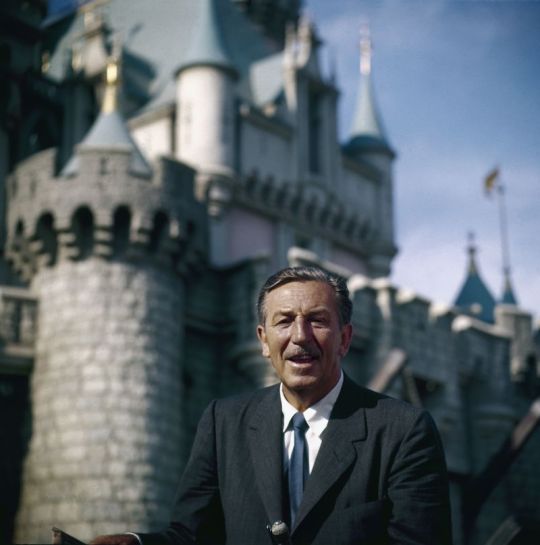
Allan Grant/The LIFE Picture Collection via Getty Images
Walt Disney at the Disneyland grand opening in 1955.
But as we come to the end of this banner year for Disney, it’s clear that what the company wants to sell us, going forward, is a seemingly infinite heap of Proustian madeleines. Certainly the warm fuzzies have been one of Disney’s main exports for a long time, but some kind of tipping point was reached in 2019. Now, it seems evident that Disney sees provoking existential homesickness as its main job. Nostalgia is its real product.
Consider Toy Story 4, the fourth film in a series that debuted in November 1995. If you were 8 years old and saw Toy Story in theaters when it opened, you might have brought your own 8-year-old to see the new film earlier this year.
That’s a remarkable stretch of time, and the Toy Story series has stayed remarkably thematically coherent over that time. It’s a set of stories about the passage of time, about how nothing stays the same, about the fact that kids grow up and leave home — that’s why Toy Story 3 left parents bawling when Andy finally grew up and didn’t need his toys anymore. The toys, in a sense, are the parents’ stand-ins. And Toy Story 4, in which some of the toys opt to live a child-free life, feels an awful lot like a movie about being an empty nester, something that could render a parent munching popcorn with their third grader a bit verklempt, thinking about their own now-empty-nester parents who once took them to see Toy Story.
That’s the good kind of nostalgia. And the Toy Story series has successfully refreshed its basic premise over two decades — toys get lost, toys get found — in part through its willingness to surprise viewers, to crack jokes and be a little creepy and think outside the (toy) box with its narratives. So when we find ourselves feeling homesick, in a story about the passage of time, it works.
I think of this approach as generative nostalgia. It’s a way for Disney to use memory, to tap into the audience’s particular madeleines, to bolster the storytelling itself (and make an enormous wad of cash, too). Not every attempt lands, but when movie studios try to tap into nostalgia in order to generate fresh new stories with universal themes, to get creative with the familiar, it’s a good thing for art.

Pixar Animation Studios / Walt Disney Pictures
From Toy Story 4, we got Forky.
If Toy Story 4 was an example of Disney harnessing generative nostalgia, however, its so-called “live-action” remake of The Lion King was just the opposite. The film was never meant to be a standalone movie; its success was always fully dependent on the long-entrenched popularity of the 1994 animated film it recreates, in some cases shot for shot. It’s an entirely unnecessary movie — a way for Disney to test-drive high-end, lifelike CGI and get people to pay for it. And without the imaginative, sometimes visually wild artwork of the original, it falls very flat, with no new perspective on its source material.
Call it derivative nostalgia: For most audiences, The Lion King and Disney’s other live-action remakes (Aladdin was another huge hit this year) are interesting only insofar as they promise to deliver a (slightly) new spin on a beloved classic, without straying too far. We still get “Can You Feel the Love Tonight,” but it’s Donald Glover and Beyoncé. A copy of the original with some of the details tweaked. That’s the appeal.
And while derivative nostalgia has its place — we rewatch our favorite movies for a reason, because we like the feelings and memories they provoke — Disney seems intent on adopting it as a modus operandi, judging from the number of remakes the company has announced. It will depend on the built-in audience of people who loved Lady and the Tramp or 101 Dalmatians to pony up for a ticket or subscribe to Disney+ and ensure these projects’ success.
But I’m convinced the urge to use your giant piles of money to endlessly replicate the past can’t be good for a culture. Certainly, human culture is cumulative; we’re always building on what came before. For millennia, storytellers have leaned on the same material, like myths and archetypes, to find new ways to tell stories. But derivative nostalgia stymies the creative impulse, miring us in the same thing over and over again and training audiences to demand the predictable. Vanilla pudding tastes good, but there’s a lot more to food than vanilla pudding.
You can witness the battle for Disney’s soul happening inside Frozen 2
These generative and derivative modes of nostalgia seem to be warring inside inside Frozen 2, which is pleasing and enjoyable even if it’s clearly designed to function as an ATM for Disney, with Frozen’s previously established fanbase acting as the bank account behind the screen. It is, thank God, no Olaf’s Frozen Adventure.
The Frozen films are aimed primarily at little girls and boys, of course — Disney’s long-running core constituency for stories about princesses and talking animals (or snowmen). But, given that the first movie came out six years ago, Frozen 2 is also for older kids. And one of the most notable things about the movie is that it’s also for their parents.
Perhaps following Pixar’s lead, the more traditional Disney Animation studio has caught onto the fact that if you want grown-ups to be happy when they take kids to the movie theater, you’ve got to make something they’ll enjoy, too. So Frozen 2 leans (more noticeably than its predecessor) into jokes the adults will appreciate, and one in particular: While the kids at my screening howled at Olaf’s slapsticky misadventures, the adults were the ones laughing as Princess Anna’s hunky boyfriend Kristoff crooned his very ’80s-sounding power ballad “Lost in the Woods.”
During a recent interview, Josh Gad (who voices Olaf) joked that the song “speaks to all of us that grew up in the ’80s.” And he’s totally right. The voice of Kristoff, Jonathan Groff, says he was surprised when the song was handed to him: “I couldn’t believe that they were going to go there,” he said, calling it “truly shocking” and later saying it has the energy of Michael Bolton. The song is about how much Kristoff needs Anna in his life; in the film, he sings it during a fantasy sequence of finding her, backed by a chorus of singing reindeer. (The official Frozen 2 soundtrack includes a version of the song by Weezer, which kind of says everything.)
As Gad pointed out, it’s definitely a sight gag for the olds in the room — the younger Gen X and older millennial parents who’ve come to see Frozen 2 with their kids, and are now being rewarded with their own extended musical joke. What’s funny about it is that the musical-style “Into the Woods” parodies was already ridiculous by the time most gen-Xers and millennials became adults; what we’re reminded of now is the sheer goofiness that was so prevalent back then, when romantic ballads were sung by guys with bad hair surrounded by unironic kitsch.
Kids born in the 21st century won’t get the joke. But Frozen 2 isn’t exclusively for them; it’s for 20th-century kids, too. In fact, though its action is set just three years after the end of Frozen, it is, like Toy Story, about the passage of time, and what it’s like to grow older. Olaf sings a song about how things don’t make sense to him now, but they will someday; Anna and Olaf reflect on how they hope everything will stay the same, even though — spoiler alert — of course, they won’t.
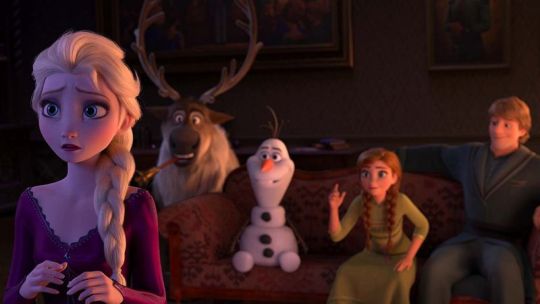
Walt Disney Pictures
The gang’s all back together in Frozen 2.
So Frozen 2 provokes all kinds of nostalgia. For kids who’ve already spent years dressing up as Anna and Elsa and driving their parents to distraction with “Let It Go,” the new film is a return to the happy land of Arendelle, where they’ve had many adventures. For teenagers who saw the original Frozen when they were 8 or so, but are now in high school, it’s a reminder of how far they’ve come. And for adults, it tugs on decades-old heartstrings — not just the chuckling memory of’ 80s power ballads, which might be the madeleine that reminds some of dancing at prom, but also the Disney princess stories so many of us grew up watching.
Whereas the original Frozen is a bit of an odd film — its plot structure feels a little out-of-sync with Disney’s usual storytelling, and its “true love’s kiss” comes not from a prince but a sister — Frozen 2 is much more conventional. Frozen retained some of the eerie strangeness of the Hans Christian Andersen fairy tale it was (very) loosely based on; Frozen 2 goes back to the usual adventure-and-return structure that has made so many classic Disney movies a success. It’s familiar. It’s comfortable.
By my lights, Frozen 2 is still a plenty enjoyable film, even if it lacks its predecessor’s subversive spark. But for me, watching generative and derivative nostalgia spar within it prompted a different sense of the familiar: bleakness about the future of mouse-eared entertainment. Disney, whatever its faults, has often been a pioneer in storytelling; now it’s resting firmly on its laurels, too often electing to spin the wheel again rather than try to reinvent it.
Nostalgia has its place. Remembering the feeling of homesickness reminds us where we came from, that we come from somewhere. But too much yearning for the past without a concomitant attempt to live in the present and push toward the future is a dangerous trap for a culture to fall into, both because it risks becoming stagnant in its art and because it may begin to to worship the past as the only place worth living in. Too much yearning for the past makes us incurious about the world. And if, as Proust wrote, the past we remember is not necessarily the one that existed, remaining stubbornly beholden to it can render us altogether incapable of dealing with the present.
The bigger Disney gets, the more it controls what most Americans — and people around the world — will see at the movies and on their TV screens, and thus it bears enormous responsibility for seeing into the future. Looking backward too much, recycling old content and relying on old formulas endlessly, becomes a snake eating its own tail.
As the endless stream of reboots and remakes and sequels and revivals that currently dominates entertainment attests, nostalgia sells. But it is also the thing most easily packaged to sell. Recycling content is the low-hanging fruit. And when Disney leans into the least creative sort of recycled content, live-action remakes — something nobody’s really asking for — it’s signaling how little it’s interested in originality.
Even when those remakes take a risk — for instance, by casting black actress Halle Bailey as Ariel in The Little Mermaid — it’s worth noting how safe the “risk” really is. Being a creative leader who celebrates inclusivity means daring to build something new, and trusting the artists to draw audiences into a new story. It doesn’t mean casting new faces in old, well-trodden roles with guaranteed built-in audiences because you’re not sure audiences will turn up otherwise. It doesn’t mean defaulting to reviving your past.
Which, ironically, is something Walt Disney was determined to keep his company from doing. As quoted in the 2007 Disney animated film Meet the Robinsons, he pushed for just the opposite: “Around here, however, we don’t look backwards for very long. We keep moving forward, opening up new doors and doing new things, because we’re curious. And curiosity keeps leading us down new paths.”
Frozen 2 opens in theaters on November 21.
from Vox - All https://ift.tt/2OvMLXf
0 notes
Text
On Frozen 2 and Disney’s nostalgia problem
Elsa’s back. | Walt Disney Pictures
Disney used to always be looking forward. These days, it increasingly only looks back.
Nobody was more nostalgic than Marcel Proust.
The French novelist’s six-volume masterwork In Search of Lost Time is narrated by a man who’s remembering his youth, and it explores how strange and unreliable memory can be. Throughout the series, the notion of “involuntary” memory is a recurring theme, but it’s particularly important in the famous “madeleine” scene.
The scene comes early in the first volume, Swann’s Way, when the taste of a madeleine dipped in tea immediately plunges the narrator into a vivid childhood memory. It’s so well-known that it remains a cultural reference point even today, more than a century after Swann’s Way was published: To say that something is your “madeleine” is shorthand for any sensory experience that brings back a flood of childhood memories (even though mounting evidence suggests that Proust’s version may have just been soggy toast).
That sensory experiences can trigger powerful memories, particularly of youth and childhood, was not a particularly earth-shattering insight on Proust’s part — lots of people have had similar episodes. And while not all of his narrator’s recollections are fond, a lot of them seem presented through a haze of affection — the reliability of which, as the narrator us himself, is a little suspect. “Remembrance of things past is not necessarily the remembrance of things as they were,” he writes.
Maurice Rougemont/Gamma-Rapho/Getty Images
Marcel Proust famously wrote about madeleines as he explored the ways our memories are triggered.
Proust aptly describes the concept of nostalgia: a sentimental yearning for the past, which Merriam Webster defines, succinctly and evocatively, as “the state of being homesick.” And while we periodically recall certain moments as being worse than they actually were (I think of the 30 Rock episode in which Liz Lemon is shocked to discover that her memories of being bullied in high school are faulty, and she was the one doing the bullying), the past often takes on a rosy hue.
Time, distance, and the occasional dash of willful ignorance are effective modifiers. They’re why societies collectively hallucinate Golden Ages, and why so many people find the idea of making America “great again” appealing. It’s less about conserving the good of the past, and more about rejecting the present.
Nostalgia is not, as a mood, inherently bad. Sometimes, feeling a bit homesick is good. But when that feeling becomes our default posture, our guiding light, it starts to become ... troubling? Inhibiting, maybe? Stifling? If the past was when things were good, why bother to build a new future? Better to just keep reinventing the past.
Which brings us to Disney, and to Frozen 2.
Disney used to be a company that looked forward. These days, it seems more interested in looking back.
Disney now controls the lion’s share of the movie industry. In 2019 so far, five of the six highest-grossing films worldwide have been Disney properties; the sixth (Spider-Man: Far From Home) was a joint endeavor between Sony and Disney-owned Marvel. The company’s reach is staggering: It owns, among scores other entities, Pixar, the Marvel Cinematic Universe, Star Wars, and as of earlier this year, the film and TV assets formerly held by 21st Century Fox — in addition to its own extensive and much-beloved back catalog, lots of which is now available to stream via the just-launched Disney+ service.
Disney is in the entertainment business. But what it’s selling isn’t entertainment, exactly — that’s just the vehicle for its real product, and that product has shifted and morphed over time. At one time, a big part of what Disney was selling was a vision of a utopian future, as you know, if you’ve been to Tomorrowland or Epcot at Walt Disney World.
In his speech at the opening day of Disneyland in 1955, Walt Disney himself pointed to his vision of the park as a place where nostalgia and forward-looking inspiration could coexist: “Here age relives fond memories of the past, and here youth may savor the challenge and promise of the future.”
Allan Grant/The LIFE Picture Collection via Getty Images
Walt Disney at the Disneyland grand opening in 1955.
But as we come to the end of this banner year for Disney, it’s clear that what the company wants to sell us, going forward, is a seemingly infinite heap of Proustian madeleines. Certainly the warm fuzzies have been one of Disney’s main exports for a long time, but some kind of tipping point was reached in 2019. Now, it seems evident that Disney sees provoking existential homesickness as its main job. Nostalgia is its real product.
Consider Toy Story 4, the fourth film in a series that debuted in November 1995. If you were 8 years old and saw Toy Story in theaters when it opened, you might have brought your own 8-year-old to see the new film earlier this year.
That’s a remarkable stretch of time, and the Toy Story series has stayed remarkably thematically coherent over that time. It’s a set of stories about the passage of time, about how nothing stays the same, about the fact that kids grow up and leave home — that’s why Toy Story 3 left parents bawling when Andy finally grew up and didn’t need his toys anymore. The toys, in a sense, are the parents’ stand-ins. And Toy Story 4, in which some of the toys opt to live a child-free life, feels an awful lot like a movie about being an empty nester, something that could render a parent munching popcorn with their third grader a bit verklempt, thinking about their own now-empty-nester parents who once took them to see Toy Story.
That’s the good kind of nostalgia. And the Toy Story series has successfully refreshed its basic premise over two decades — toys get lost, toys get found — in part through its willingness to surprise viewers, to crack jokes and be a little creepy and think outside the (toy) box with its narratives. So when we find ourselves feeling homesick, in a story about the passage of time, it works.
I think of this approach as generative nostalgia. It’s a way for Disney to use memory, to tap into the audience’s particular madeleines, to bolster the storytelling itself (and make an enormous wad of cash, too). Not every attempt lands, but when movie studios try to tap into nostalgia in order to generate fresh new stories with universal themes, to get creative with the familiar, it’s a good thing for art.
Pixar Animation Studios / Walt Disney Pictures
From Toy Story 4, we got Forky.
If Toy Story 4 was an example of Disney harnessing generative nostalgia, however, its so-called “live-action” remake of The Lion King was just the opposite. The film was never meant to be a standalone movie; its success was always fully dependent on the long-entrenched popularity of the 1994 animated film it recreates, in some cases shot for shot. It’s an entirely unnecessary movie — a way for Disney to test-drive high-end, lifelike CGI and get people to pay for it. And without the imaginative, sometimes visually wild artwork of the original, it falls very flat, with no new perspective on its source material.
Call it derivative nostalgia: For most audiences, The Lion King and Disney’s other live-action remakes (Aladdin was another huge hit this year) are interesting only insofar as they promise to deliver a (slightly) new spin on a beloved classic, without straying too far. We still get “Can You Feel the Love Tonight,” but it’s Donald Glover and Beyoncé. A copy of the original with some of the details tweaked. That’s the appeal.
And while derivative nostalgia has its place — we rewatch our favorite movies for a reason, because we like the feelings and memories they provoke — Disney seems intent on adopting it as a modus operandi, judging from the number of remakes the company has announced. It will depend on the built-in audience of people who loved Lady and the Tramp or 101 Dalmatians to pony up for a ticket or subscribe to Disney+ and ensure these projects’ success.
But I’m convinced the urge to use your giant piles of money to endlessly replicate the past can’t be good for a culture. Certainly, human culture is cumulative; we’re always building on what came before. For millennia, storytellers have leaned on the same material, like myths and archetypes, to find new ways to tell stories. But derivative nostalgia stymies the creative impulse, miring us in the same thing over and over again and training audiences to demand the predictable. Vanilla pudding tastes good, but there’s a lot more to food than vanilla pudding.
You can witness the battle for Disney’s soul happening inside Frozen 2
These generative and derivative modes of nostalgia seem to be warring inside inside Frozen 2, which is pleasing and enjoyable even if it’s clearly designed to function as an ATM for Disney, with Frozen’s previously established fanbase acting as the bank account behind the screen. It is, thank God, no Olaf’s Frozen Adventure.
The Frozen films are aimed primarily at little girls and boys, of course — Disney’s long-running core constituency for stories about princesses and talking animals (or snowmen). But, given that the first movie came out six years ago, Frozen 2 is also for older kids. And one of the most notable things about the movie is that it’s also for their parents.
Perhaps following Pixar’s lead, the more traditional Disney Animation studio has caught onto the fact that if you want grown-ups to be happy when they take kids to the movie theater, you’ve got to make something they’ll enjoy, too. So Frozen 2 leans (more noticeably than its predecessor) into jokes the adults will appreciate, and one in particular: While the kids at my screening howled at Olaf’s slapsticky misadventures, the adults were the ones laughing as Princess Anna’s hunky boyfriend Kristoff crooned his very ’80s-sounding power ballad “Lost in the Woods.”
During a recent interview, Josh Gad (who voices Olaf) joked that the song “speaks to all of us that grew up in the ’80s.” And he’s totally right. The voice of Kristoff, Jonathan Groff, says he was surprised when the song was handed to him: “I couldn’t believe that they were going to go there,” he said, calling it “truly shocking” and later saying it has the energy of Michael Bolton. The song is about how much Kristoff needs Anna in his life; in the film, he sings it during a fantasy sequence of finding her, backed by a chorus of singing reindeer. (The official Frozen 2 soundtrack includes a version of the song by Weezer, which kind of says everything.)
As Gad pointed out, it’s definitely a sight gag for the olds in the room — the younger Gen X and older millennial parents who’ve come to see Frozen 2 with their kids, and are now being rewarded with their own extended musical joke. What’s funny about it is that the musical-style “Into the Woods” parodies was already ridiculous by the time most gen-Xers and millennials became adults; what we’re reminded of now is the sheer goofiness that was so prevalent back then, when romantic ballads were sung by guys with bad hair surrounded by unironic kitsch.
Kids born in the 21st century won’t get the joke. But Frozen 2 isn’t exclusively for them; it’s for 20th-century kids, too. In fact, though its action is set just three years after the end of Frozen, it is, like Toy Story, about the passage of time, and what it’s like to grow older. Olaf sings a song about how things don’t make sense to him now, but they will someday; Anna and Olaf reflect on how they hope everything will stay the same, even though — spoiler alert — of course, they won’t.
Walt Disney Pictures
The gang’s all back together in Frozen 2.
So Frozen 2 provokes all kinds of nostalgia. For kids who’ve already spent years dressing up as Anna and Elsa and driving their parents to distraction with “Let It Go,” the new film is a return to the happy land of Arendelle, where they’ve had many adventures. For teenagers who saw the original Frozen when they were 8 or so, but are now in high school, it’s a reminder of how far they’ve come. And for adults, it tugs on decades-old heartstrings — not just the chuckling memory of’ 80s power ballads, which might be the madeleine that reminds some of dancing at prom, but also the Disney princess stories so many of us grew up watching.
Whereas the original Frozen is a bit of an odd film — its plot structure feels a little out-of-sync with Disney’s usual storytelling, and its “true love’s kiss” comes not from a prince but a sister — Frozen 2 is much more conventional. Frozen retained some of the eerie strangeness of the Hans Christian Andersen fairy tale it was (very) loosely based on; Frozen 2 goes back to the usual adventure-and-return structure that has made so many classic Disney movies a success. It’s familiar. It’s comfortable.
By my lights, Frozen 2 is still a plenty enjoyable film, even if it lacks its predecessor’s subversive spark. But for me, watching generative and derivative nostalgia spar within it prompted a different sense of the familiar: bleakness about the future of mouse-eared entertainment. Disney, whatever its faults, has often been a pioneer in storytelling; now it’s resting firmly on its laurels, too often electing to spin the wheel again rather than try to reinvent it.
Nostalgia has its place. Remembering the feeling of homesickness reminds us where we came from, that we come from somewhere. But too much yearning for the past without a concomitant attempt to live in the present and push toward the future is a dangerous trap for a culture to fall into, both because it risks becoming stagnant in its art and because it may begin to to worship the past as the only place worth living in. Too much yearning for the past makes us incurious about the world. And if, as Proust wrote, the past we remember is not necessarily the one that existed, remaining stubbornly beholden to it can render us altogether incapable of dealing with the present.
The bigger Disney gets, the more it controls what most Americans — and people around the world — will see at the movies and on their TV screens, and thus it bears enormous responsibility for seeing into the future. Looking backward too much, recycling old content and relying on old formulas endlessly, becomes a snake eating its own tail.
As the endless stream of reboots and remakes and sequels and revivals that currently dominates entertainment attests, nostalgia sells. But it is also the thing most easily packaged to sell. Recycling content is the low-hanging fruit. And when Disney leans into the least creative sort of recycled content, live-action remakes — something nobody’s really asking for — it’s signaling how little it’s interested in originality.
Even when those remakes take a risk — for instance, by casting black actress Halle Bailey as Ariel in The Little Mermaid — it’s worth noting how safe the “risk” really is. Being a creative leader who celebrates inclusivity means daring to build something new, and trusting the artists to draw audiences into a new story. It doesn’t mean casting new faces in old, well-trodden roles with guaranteed built-in audiences because you’re not sure audiences will turn up otherwise. It doesn’t mean defaulting to reviving your past.
Which, ironically, is something Walt Disney was determined to keep his company from doing. As quoted in the 2007 Disney animated film Meet the Robinsons, he pushed for just the opposite: “Around here, however, we don’t look backwards for very long. We keep moving forward, opening up new doors and doing new things, because we’re curious. And curiosity keeps leading us down new paths.”
Frozen 2 opens in theaters on November 21.
from Vox - All https://ift.tt/2OvMLXf
0 notes